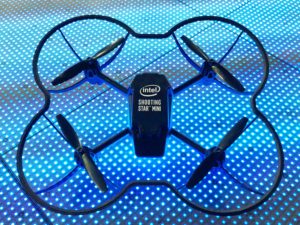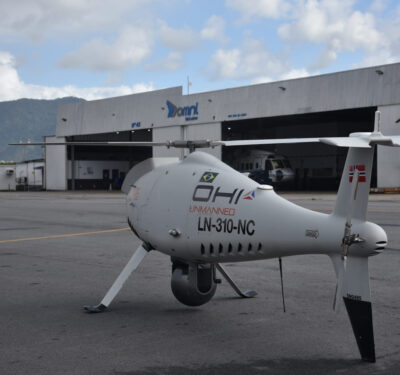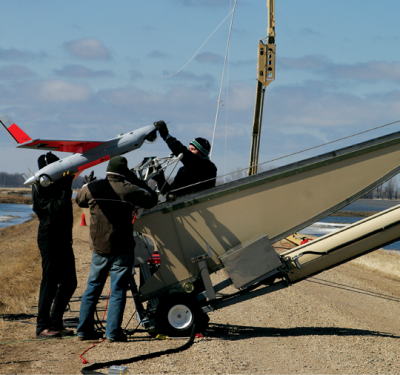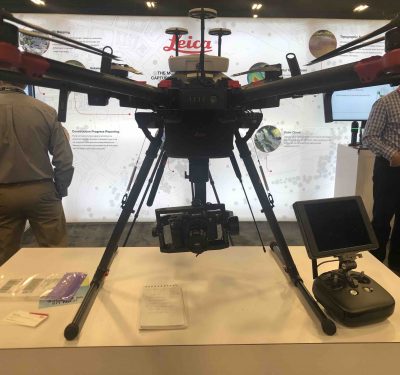
The Intel Shooting Star Mini drone is the company’s first drone designed and built to enable indoor light show experiences. It is designed with a super-lightweight structure and propeller guards for safety. Its light source can create more than 4 billion color combinations designed for visually stunning aerial displays. (Credit: Intel Corporation)
At this week’s opening keynote for CES 2018 in Las Vegas, Intel CEO Brian Krzanich demonstrated how Intel is powering the next wave of innovation in the sky. From an autonomous aircraft powered by Intel “smarts,” to new capabilities for indoor light show entertainment, the Las Vegas skies were quite literally the limit for Intel drone technology as 250 Intel® Shooting Star™ drones took flight for an aerial performance over the Fountains of Bellagio.
Also this week at CES, Mobileye, an Intel company, the global leader in advanced driver assistance systems (ADAS) and autonomous driving technologies, and NavInfo, the leading autonomous driving solution providers in the China market with core businesses in HAD mapping and high accuracy positioning, announced they have agreed to a collaboration intended to build and distribute Mobileye’s Road Experience Management (REM®) product in China. Specifically, the partnership’s purpose is to use Mobileye’s REM technology to generate a RoadBook™ in China that is integrated and aligned with NavInfo’s mapping solutions.
Announcement highlights from the company included:
- Intel® Flight Control Technology powers the Volocopter– the first fully electric, vertical take-off and landing aircraft, designed for passenger transport. Intel® Flight Control Technology is based on the intelligence found in the Intel Falcon™ 8+ drone used for inspection, surveying, and mapping, showing the powerful intersection of data and autonomous technology.
- Intel brings the first-ever drone light show to the Las Vegas Stripthis week with nightly performances at the iconic Fountains of Bellagio. Audiences are experiencing the magic of Intel technology as a fleet of 250 Intel® Shooting Star™ drones light up the sky, integrated with the Fountains of Bellagio to the song, “Stargazing,” by Kygo.
- Intel® set a new Guinness World Record™on Monday night during the CES opening keynote, presenting a spectacular indoor light show performed by 100 Intel® Shooting Star Mini drones. This marks the record for the most drones flown simultaneously indoors by a single pilot. The Intel Shooting Star Mini drone is Intel’s newly designed drone for indoor light shows and built from the ground up so that it can safely fly and navigate the indoors where there is no GPS.
Intel Technology Powers Volocopter
Beyond autonomous cars, Krzanich also demonstrated the Volocopter during his keynote, a fully electric, vertical take-off and landing aircraft designed for passenger transport. The Intel® Flight Control Technology used in the Volocopter is based on the intelligence found in the Intel Falcon™ 8+ drone used for inspection, surveying, and mapping, showing the powerful intersection of data and autonomous technology. The Intel flight control technology analyzes environmental data with highly redundant sensors and is able to compensate for certain flight malfunctions. It can also accommodate for certain wind gusts and shifts in the center of gravity to help stabilize the position of the aircraft.
Since joining forces in 2013, the Volocopter has successfully flown more than 400 times, however, Monday night was the first time ever flying in North America. Intel aims to bring a new level of reliability and safety to autonomous transportation, and solve unique challenges of our time, such as traffic and pollution, according to an Intel press release.
Intel® Shooting Star™ Mini Drone
Intel® set a new Guinness World Record™ during Krzanich’s keynote, where he presented a spectacular indoor light show performed by 100 Intel® Shooting Star Mini drones. This marks the record for the most drones flown simultaneously indoors by a single pilot.
The Intel Shooting Star Mini drone is Intel’s newly designed drone for indoor light shows so that it can safely fly and navigate the indoors where there is no GPS. It is a quadcopter made of a super lightweight structure, has propeller guards, and fits in the palm of your hand. Its light source can create over four billion color combinations to create beautiful aerial displays. According to Intel, it has the most advanced software, is fully automated and a single fleet can be controlled by one pilot.
The Intel® Indoor Location System helps the drones navigate indoor spaces, expanding the company’s possibilities for entertainment with choreographed drone light shows in enclosed venues. With the software and animation tools on the Intel® Shooting Star™ Mini System, a drone light show can be created in a matter of weeks instead of months. Intel Shooting Star Mini drones create a more streamlined way to design, and can efficiently operate with one computer controlling a single fleet.
This drone is the counterpart to the Intel® Shooting Star™ drone that has been illuminating the night skies around the world at music festivals like Coachella, last year’s Super Bowl Half Time Show, at celebrations across Asia, and more.

Professor Amnon Shashua, CEO and CTO of Mobileye, talks about the collaboration with NavInfo. (Credit: Intel Corporation)
Mobileye – NavInfo Collaboration
Mobileye’s REM system is a cost-efficient solution to enable autonomous vehicles (AV) to localize themselves much more accurately than traditional approaches can support. Low bandwidth, anonymized data packets from vehicles equipped with front-facing cameras are used to crowd-source a RoadBook of drivable paths, including road/lane boundaries and the stationary landmarks used as reference points. This is a critical sensory input to automated vehicles all the way from Level 2+ systems to Level 5. This innovative, low-cost solution to one of autonomous driving’s largest challenges (precision localization/mapping) has garnered significant interest from OEMs and mapping companies worldwide, and through this arrangement will now be coming to China.
NavInfo’s skills and products are highly complementary to Mobileye in terms of productizing and distributing REM in China. The RoadBook contains no navigational or geographic information, therefore it needs to be delivered as a layer within NavInfo’s map products. NavInfo software and other technology can also support alignment of the rapidly updating RoadBook inside NavInfo’s standard map and HAD map. Distribution of this aligned product will enable future AV systems in China to gain the localization capabilities needed for real automation.
“Mobileye has a history of pursuing partnerships with innovative companies which we believe results in faster-to-market products that support the pillars of safety and economic scalability,” said Professor Amnon Shashua, CEO and CTO of Mobileye. “We are very pleased to announce our relationship with NavInfo as the latest example. NavInfo’s technology and market position make it a natural fit to assist in building RoadBook in China, and thereby accelerating the next steps of autonomous driving.”
“We are always excited about joining forces and uniting market leaders to fuel innovation and inspiration across the world,” said Patrick Cheng, CEO, NavInfo. “We truly believe with Mobileye’s vision and technology, together we can offer state-of-the-art solutions to connect our customers with best-in-class services and take the autonomous driving industry to the next level.”






